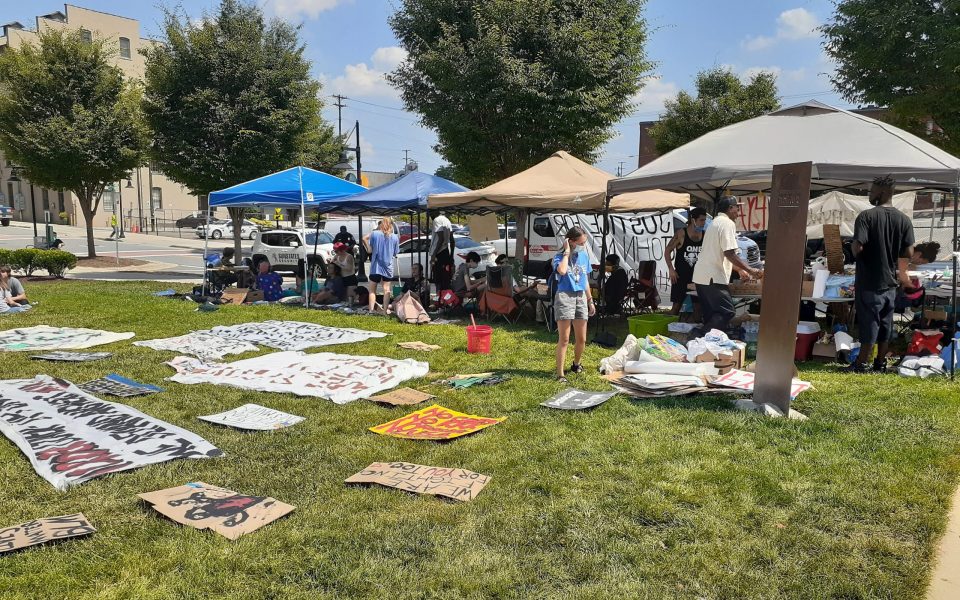
It’s Day 6 of the Winston-Salem occupation, a Monday, early afternoon. And even though it’s the hottest part of the day, people are starting to gather at the encampment at Bailey Park.
Brittany Battle is here, still sort of reeling from her July 8 arrest just a couple blocks away, but she’s got to get back to Wake Forest University to train on distance-learning software before her classes begin in a few weeks. All the professors are doing it. There’s a group of white siblings that everyone is calling “the Triplets” who have been out here every day so far, from 10 a.m. to 10 p.m., sitting under the tents, writing letters, getting educated. A few people have brought their baseball mitts and they’re having a catch on the lawn while some hip-hop, not too loud — breathes from an unseen speaker by the snack table.
Tonight, again, there will be some speakers from activism, academia and entertainment, followed by the nightly vigil.
“I’ve been saying: The movement is multidimensional,” Battle says.
On the benches outside Fair Witness, which the leaders have been using as an informal office these last six days, Bailey Pittenger from the Triad Abolition Project explains the point of the whole thing.
On Dec. 4, 2019, John Neville of Greensboro died shortly after being admitted to the Forsyth County Law Enforcement Detention Center. But nobody knew about it until June 26, when the story broke in the press, and nothing happened until July 8, when Forsyth DA Jim O’Neill, along with Sheriff Bobby Kimbrough, announced that five corrections officers would be charged with involuntary manslaughter. That was the night that Battle, along with four other activists, were arrested while marching around the jail. The next morning, the SBI released an autopsy revealing that Neville died from a brain injury sustained while he was hogtied in the jail. That night, 15 more protesters were arrested on the street.
The public has not yet seen the video capturing Neville’s demise.
“We’re very certain it’s a cover-up,” Pittenger says.
TAP means what it says — they are for the complete abolition of traditional law enforcement and the prison-industrial complex, favoring instead a net of social services and community resources that Pittenger says will help us redefine what “crime” means. She’s out here every day to stay on message.
“We’re building that scaffolding of information,” she says, and also creating alliances with other organizations to keep the occupation going. She stays in close contact with the ACLU, some other local activist organizations and anyone else who wants to lend their body to the occupation.
“It will last,” she says, “until we get all of our demands met.” Those include answers to all questions regarding John Neville, policy changes to ensure this doesn’t happen again and dismissal of all charges against the protesters.
It’s an old-school tactic, honed during the Occupy Wall Street days almost 10 years ago, when the target wasn’t law enforcement but income inequality and the ravages of capitalism. But on Nov. 15, 2011, after about two months of occupation, New York City cops in riot gear cleared Zuccotti Park, arresting some 200 protesters and journalists on the sweep.
Like Zuccotti, Bailey Park is privately owned, but Pittenger says she knows the cops are close by.
“In the first few days there were unmarked cars watching us,” she says, “but now we can’t physically see them.
“We feel watched.”
Which, of course, is very different from being seen.
Join the First Amendment Society, a membership that goes directly to funding TCB‘s newsroom.
We believe that reporting can save the world.
The TCB First Amendment Society recognizes the vital role of a free, unfettered press with a bundling of local experiences designed to build community, and unique engagements with our newsroom that will help you understand, and shape, local journalism’s critical role in uplifting the people in our cities.
All revenue goes directly into the newsroom as reporters’ salaries and freelance commissions.


Leave a Reply